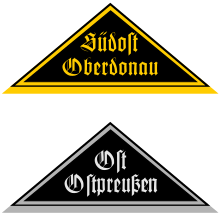Traditional arm triangle
The traditional arm triangle of the Hitler Youth (HJ) was a special form of the area triangle ( arm triangle ). It was created to identify those members of the HJ who were already members of the HJ / DJ or the BDM / JM before January 30, 1933 and the " seizure of power " by the National Socialists . Membership in the NSDAP or its branches such as the SA , SS , NSBO , etc. were taken into account.
Appearance
The basis for the design of the traditional arm triangle was the area triangle that the wearer (or wearer) wore on the uniform. From the inscription of the arm triangle, the territorial affiliation to the upper area and area of the carrier could be recognized.
The traditional arm triangle was given an additional identifier by a woven wire around 7 mm wide, which was gold-colored for HJ / DJ and silver-colored for BDM / JM. It consisted of several longitudinal bulges, the middle of which was thickened. This heddle was sewn onto the usual area triangle in such a way that its yellow (white) lower line was covered.
introduction
The traditional arm-triangle should for the first time Reichsparteitag be worn 1935th For this purpose, after a request in this regard had been confirmed, the badges were awarded to the bearer in question by the leader of the area as part of an appeal.
See also
literature
- Ordinance sheet of the RJF, II / 8, of July 28, 1934, structure and badge of the HJ , published by the RJF 1940.
- Schultheis, Carlo: Die area triangle of the HJ , Internationales Militaria-Magazin (magazine), No. 128, June / July 2007, pp. 31–34.
